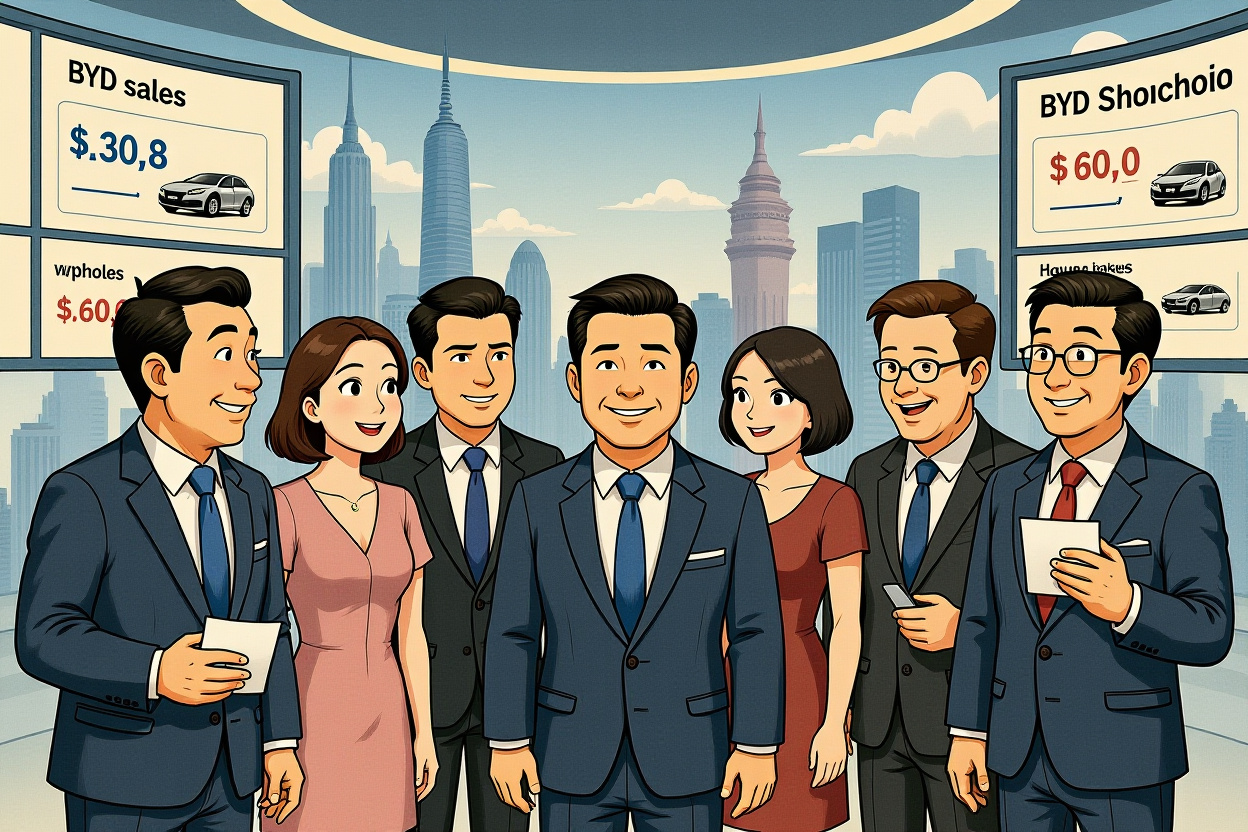BYD’s Remarkable Sales Surge in Europe
In a stunning market shift, BYD has not only caught up with Tesla in European electric vehicle sales but has surged significantly ahead. Recent data reveals that in July 2025, BYD sold 13,500 units across Europe, marking an extraordinary 225% year-on-year growth. Meanwhile, Tesla managed 9,938 units during the same period. This isn’t a marginal lead—it’s a substantial gap that continues to widen month after month.
What makes this achievement particularly noteworthy is that BYD accomplished this without competing on price. In fact, BYD’s vehicles command premium prices in Europe, often exceeding those of Tesla models. The ATTO 3 (known as Yuan Plus in China) starts at €38,000, while Tesla’s Model 3 begins at €33,000. Even the more compact ATTO 2 (Yuan UP) is priced at €29,000, reflecting a strategic decision to position BYD as a quality-focused brand rather than a budget alternative.
Why BYD’s European Pricing Strategy Works
Many assume that Chinese automakers rely on low prices to gain market share. However, BYD’s success in Europe debunks this myth. The company’s vehicles are priced significantly higher in Europe than in China—often two to three times more. For instance, the Yuan UP, which starts at 74,800 RMB in China, is sold as the ATTO 2 in Europe with a starting price of €29,000 (approximately 225,000 RMB).
This pricing strategy isn’t arbitrary. European governments impose tariffs and regulations to protect local automakers like Volkswagen and Stellantis. If BYD were to sell its vehicles at Chinese price points, it would disrupt the market and potentially threaten the survival of European brands. Thus, BYD’s premium pricing is both a necessity and a deliberate brand-building tactic.
Market Protectionism and Its Impact
Europe’s automotive industry is a cornerstone of its economy, employing millions and contributing significantly to GDP. To safeguard this, the European Union has implemented policies that make it difficult for foreign automakers to undercut local manufacturers on price. BYD’s compliance with these regulations has allowed it to avoid trade disputes while still competing effectively.
Elon Musk’s Political Missteps and Tesla’s Brand Erosion
One of the critical factors behind BYD’s rise is the decline in Tesla’s brand reputation in Europe. Elon Musk’s increasingly polarizing political statements have alienated many European consumers. His public endorsement of far-right parties like Germany’s Alternative für Deutschland (AfD) and similar groups in France and the UK has been widely criticized as interference in domestic politics.
Europeans, who generally value political stability and social cohesion, have reacted negatively to Musk’s interventions. Tesla, once seen as a visionary brand, is now associated with political controversy. This has eroded consumer trust and willingness to purchase Tesla vehicles, creating an opening for competitors like BYD.
The Role of Corporate Leadership in Brand Perception
A CEO’s public persona can significantly impact a company’s brand. Musk’s actions have overshadowed Tesla’s innovations, leading to a decline in sales despite the company’s technological advancements. In contrast, BYD has maintained a low-profile, pragmatic image, focusing on product quality and reliability rather than political statements.
The End of EV Subsidies and Its Ripple Effects
Another game-changer in the European EV market has been the gradual phasing out of government subsidies for electric vehicles. Many countries, including Germany and France, have reduced or eliminated incentives for EV purchases. This has made Tesla’s already expensive vehicles even less affordable for the average consumer.
Without subsidies, the price gap between electric and internal combustion engine (ICE) vehicles has widened, prompting some buyers to revert to traditional cars. However, BYD has been less affected by this shift due to its diverse product lineup, which includes plug-in hybrids (PHEVs) alongside pure electric vehicles (BEVs).
Why Plug-In Hybrids Are Thriving in Europe
Plug-in hybrids have emerged as the preferred choice for many European consumers transitioning from ICE vehicles to electrified options. PHEVs offer the flexibility of electric driving for daily commutes while providing the security of a gasoline engine for longer trips. This is particularly valuable in regions where charging infrastructure is still developing.
Sales data supports this trend: PHEV sales in Europe grew by over 50% in 2025, while BEV sales increased by only 30%. BYD’s strong presence in the PHEV segment has allowed it to capture a larger share of the market compared to Tesla, which exclusively produces BEVs.
BYD’s Product Diversity and Competitive Edge
While Tesla offers a limited range of vehicles—primarily the Model 3, Model Y, and upcoming Cybertruck—BYD boasts a comprehensive portfolio. From compact cars like the Dolphin to SUVs like the ATTO 3 and commercial vehicles like the Han EV, BYD caters to a wide variety of consumer needs.
This diversity is a significant advantage in a market as varied as Europe. Different countries have different preferences: for example, Southern Europeans prefer smaller cars, while Northern Europeans favor larger vehicles. BYD’s ability to offer tailored options for each segment has been instrumental in its success.
The Role of MG in Europe’s EV Landscape
BYD isn’t the only Chinese automaker making waves in Europe. MG, owned by SAIC Motor, has also seen explosive growth, with sales reaching 150,000 units in the first half of 2025 alone. Like BYD, MG offers a mix of BEVs and PHEVs, appealing to a broad audience. The success of both brands highlights a broader trend of Chinese automakers gaining traction in Europe.
Tesla’s Limitations in a Rapidly Evolving Market
Tesla’s product strategy has remained relatively static over the years. The company has yet to introduce a plug-in hybrid, an MPV, or a budget-friendly model priced below €20,000. This lack of diversity limits its appeal to cost-conscious consumers and those seeking transitional options like PHEVs.
Moreover, Tesla’s interior designs and features have been criticized for being too minimalist—often described as “spartan” or “bare-bones.” In contrast, BYD and other Chinese manufacturers offer more luxurious interiors and advanced technology at competitive prices.
The Challenge of Scaling Globally
Tesla’s production is heavily concentrated in its Gigafactories in the U.S., China, and Germany. While this centralized approach has benefits, it also creates vulnerabilities. Supply chain disruptions, geopolitical tensions, and logistical challenges can impact Tesla’s ability to meet global demand. BYD, with its extensive manufacturing base in China, has been more resilient in this regard.
The Future of Electric Vehicles in Europe
As charging infrastructure improves and consumer preferences evolve, the European EV market will continue to change. Pure electric vehicles are likely to regain momentum once range anxiety and charging accessibility are addressed. However, for now, plug-in hybrids remain the practical choice for many.
BYD’s ability to adapt to these trends—combined with its competitive pricing, diverse product range, and avoidance of political controversy—positions it well for sustained success. Tesla, on the other hand, must address its product gaps and reputational challenges to regain lost ground.
Key Takeaways for the Automotive Industry
– Diversification is critical: Offering both BEVs and PHEVs allows automakers to capture a broader audience.
– Brand perception matters: Political statements by corporate leaders can significantly impact sales.
– Local market dynamics shape strategy: Understanding regional preferences and regulations is essential for global success.
What’s Next for BYD and Tesla?
BYD’s success in Europe is a testament to its strategic agility and customer-centric approach. By offering a diverse range of high-quality vehicles and avoiding political missteps, it has carved out a leading position in the competitive EV market. Tesla, while still a formidable player, must innovate not only in technology but also in its product lineup and public relations to stay relevant.
For consumers, this competition is ultimately beneficial. It drives innovation, improves affordability, and expands choices. As the EV revolution continues, companies that prioritize adaptability and customer needs will thrive.
If you’re considering an electric vehicle, explore both BYD and Tesla’s offerings to find the best fit for your lifestyle and budget. The future of driving is electric—and it’s more exciting than ever.




